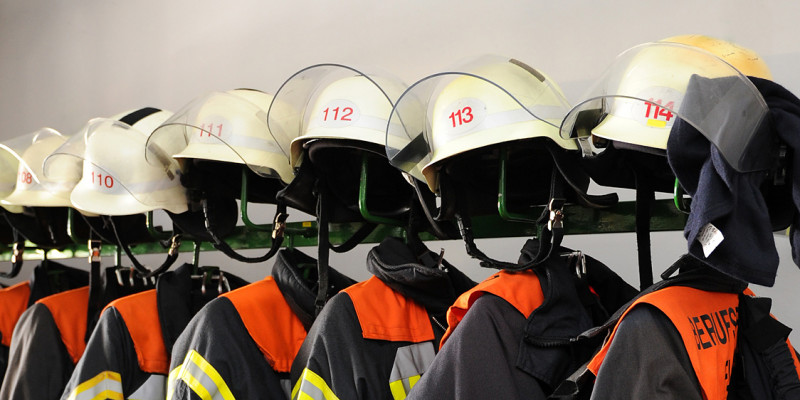Measures to cope with the increasing number of operations
The effects of climate change bring new challenges for disaster preparedness and management to which civil protection must adapt. New requirements arise above all from the expected increase in the frequency and intensity of extreme weather and weather conditions and the associated consequences.
Even under these circumstances, civil protection should be able to reliably fulfil its tasks. This includes protecting the lives and health of citizens and preventing material damage in the event of disasters and serious emergencies. Another key concern is to ensure the availability of the so-called "critical infrastructures" (CRITIS), which include energy and water supply, transport and traffic as well as telecommunications and information technology.
In order to prepare civil protection for future requirements, efficient monitoring of extreme weather events and relief operations is necessary. This requires the harmonisation of data in this area beyond individual organisations and federal states.
In addition, existing systems and measures can be further developed, for example severe weather warning systems, special disaster management planning, training programmes for dike defence, early detection of forest fires, and the use of special response resources such as vehicles, equipment and material.
Longer and more frequent interventions can be better managed by civil protection organisations if different actors also cooperate across disciplines. Various networks exist for this purpose, in which the organisations are in regular exchange with each other. One example is the Strategic Alliance of Public Authorities "Adaptation to Climate Change".
The working group "Climate Change and Adaptation in Civil Protection" brings together aid organisations active throughout Germany, the voluntary and professional fire brigades, the Federal Agency for Technical Relief (THW) and the Federal Office of Civil Protection and Disaster Assistance (BBK). The BBK, the Federal Environment Agency (UBA), the German Weather Service (DWD), the Federal Institute for Research on Building, Urban Affairs and Spatial Development at the Federal Office for Building and Regional Planning (BBSR) and the THW are already actively working together within the framework of a strategic alliance of authorities to integrate the consequences of climate change into the practice of civil protection.
Another important component of civil protection is the population's ability to protect itself. By behaving correctly in emergency situations, citizens can help to protect themselves and their fellow human beings and improve general safety. An important adaptation measure is the improvement of risk communication. Information and contact points can increase awareness of the problem and contribute to self-help. Timely and effective warning of extreme weather events can significantly increase the protection of the population.
Indicators from the monitoring on the DAS: Information on how to act in a disaster situation, Precautionary measures for protection of the public
Measures for the adaptation of civil protection organisations
Climate impacts do not only affect the tasks of civil protection. The organisations themselves can also be stressed by the changed climate conditions and must therefore adapt. For example, heat stress can push the staff of relief organisations to their performance limits. This must be taken into account when planning work. Measures such as longer breaks and increased rotation of relief workers can help.
The increased occurrence of extreme weather events entails more frequent, personnel-, material- and time-intensive operations. It is therefore of great importance to adapt staff and material resources to the changed conditions in order to cope with the additional workload caused by the consequences of climate change. In order to meet increased personnel requirements, it may become necessary in future to call in fire brigades from other municipalities or federal states or the Federal Agency for Technical Relief (THW) more often. Since civil protection organisations rely on volunteers, it is also important to promote programmes to strengthen volunteerism and youth work in order to secure staffing levels. Further potential can be tapped, for example, through the integration of spontaneous helpers - i.e. citizens who are willing to help and who mostly form and organise themselves via social platforms. In addition, training measures can be used to raise awareness of the impacts of climate change among volunteers and staff. Various organisations are already expanding their training content to specifically address the challenges of climate change for civil protection.
If extreme weather events cause critical infrastructure to fail, this can also affect civil protection itself. Adaptation measures can help to ensure operational capability in such a case. Last but not least, this includes a systematic overview of one's own dependencies on critical infrastructure. This can be the basis for a comprehensive assessment of where problems could arise and in which areas emergency supplies are needed. Based on this, measures ranging from technical solutions to emergency plans can be developed to ensure operational capability in the long term.
In addition, the equipment must also be adapted to future requirements. For example, it can be assumed that the need for fire engines with greater extinguishing agent capacity, emergency drinking water supplies, emergency power generators and fire brigades with pumps and power generators will increase.
Indicators from the monitoring on the DAS: Training exercises, Active disaster protection workers
 Click to enlarge
Click to enlarge

